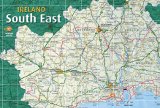South East Ireland Tourism
Travel guide to Ireland's south east
Travel guide to Ireland's south east
History of Kilkenny
Three great river highways, the Barrow, the Suir and the Nore, ensured that the lands now comprising Kilkenny received very early attention from both raiders and traders. Their early settlements can still be traced, written in stone in the landscape. In every part of the county is evidence of the benign, and sometimes malign influences, that have helped shape the history, politics and sociology of the area.
Pre-historic portal dolmens, Iron Age earth works, early Ogham stones, a plethora of early Christian monastic sites, Anglo-Norman defensive towers, imposing castles, Elizabethan manor houses and Georgian estate houses, help recall the story of a county and of a city that is rich in history and tradition.
Diarmuid Mac Murrough, the Irish King of Leinster, abducted the wife of O'Rorke, another chieftain, and thereby fell foul of the then High King, Roderick O'Conor, who banised Diarmuid from his Kingdom. Diarmuid appealed to Henry II, the Plantagenet King of England, to help him regain his territory and was authorised to raise an army from among the Anglo-Normans in Wales.
In return for their help, Diarmuid promised Richard Fitzgilbert de Clare, Earl of Pembroke - known as Strongbow - his daughter's hand in marriage and thereby established him as pretender heir to the Kingdom of Leinster. After the Anglo-Norman "invasion" of 1169, most of what is now Co. Kilkenny fell to Strongbow.
Strongbow built a motte and bailey castle in Kilkenny in 1172 to command the crossing of the Nore. On his death, his son-in-law, William the Earl Marshall, replaced it with a stone structure, establishing his seat here, where in 1204 he incorporated the town. Having passed to the de Clares and Le Despensers, James Butler, 3rd Earl of Ormond, purchased the manor and castle in 1391.
The history of the Ormond Butlers was, to a large degree, the history of Anglo-Norman relations for the following seven centuries. The name "Butler" derives from the installation by Henry II of Theobald FitzWalter as Chief Butler of Ireland in 1177. In 1328 the Butlers were created Earls of Ormond and in 1391 the family seat moved from Gowran to Kilkenny, where the family lived until 1935.
The power of the Butlers brought the city to prominence and it was the venue for much of the deliberations of the Anglo-Irish Parliament that met on 15 occasions in the 14th century. The Statutes of Kilkenny were enacted here in 1366, when it was feared that the old Anglo-Norman families were becoming "more Irish than the Irish themselves". James I elevated the liberty to the rank of City in 1609.
During the turbulent years in the reign of Charles I in England, the city was the seat of the Supreme Council of the Catholic Confederation, known as the Confederation of Kilkenny.
<< Return to Kilkenny page
Pre-historic portal dolmens, Iron Age earth works, early Ogham stones, a plethora of early Christian monastic sites, Anglo-Norman defensive towers, imposing castles, Elizabethan manor houses and Georgian estate houses, help recall the story of a county and of a city that is rich in history and tradition.
Diarmuid Mac Murrough, the Irish King of Leinster, abducted the wife of O'Rorke, another chieftain, and thereby fell foul of the then High King, Roderick O'Conor, who banised Diarmuid from his Kingdom. Diarmuid appealed to Henry II, the Plantagenet King of England, to help him regain his territory and was authorised to raise an army from among the Anglo-Normans in Wales.
In return for their help, Diarmuid promised Richard Fitzgilbert de Clare, Earl of Pembroke - known as Strongbow - his daughter's hand in marriage and thereby established him as pretender heir to the Kingdom of Leinster. After the Anglo-Norman "invasion" of 1169, most of what is now Co. Kilkenny fell to Strongbow.
Strongbow built a motte and bailey castle in Kilkenny in 1172 to command the crossing of the Nore. On his death, his son-in-law, William the Earl Marshall, replaced it with a stone structure, establishing his seat here, where in 1204 he incorporated the town. Having passed to the de Clares and Le Despensers, James Butler, 3rd Earl of Ormond, purchased the manor and castle in 1391.
The history of the Ormond Butlers was, to a large degree, the history of Anglo-Norman relations for the following seven centuries. The name "Butler" derives from the installation by Henry II of Theobald FitzWalter as Chief Butler of Ireland in 1177. In 1328 the Butlers were created Earls of Ormond and in 1391 the family seat moved from Gowran to Kilkenny, where the family lived until 1935.
The power of the Butlers brought the city to prominence and it was the venue for much of the deliberations of the Anglo-Irish Parliament that met on 15 occasions in the 14th century. The Statutes of Kilkenny were enacted here in 1366, when it was feared that the old Anglo-Norman families were becoming "more Irish than the Irish themselves". James I elevated the liberty to the rank of City in 1609.
During the turbulent years in the reign of Charles I in England, the city was the seat of the Supreme Council of the Catholic Confederation, known as the Confederation of Kilkenny.
<< Return to Kilkenny page






